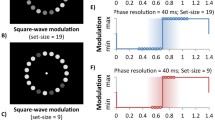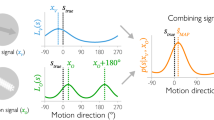Summary
We obtained movement detection thresholds for two-dimensional random speck-patterns (“Julesz” patterns) homogeneously moving over the whole target field (5.21×5.31 degrees of visual angle). We alternated between two uncorrelated but otherwise similar patterns, one moving with velocity →v1, the other with velocity →v2, such that each pattern was on for T ms. We masked this pattern (signal) with spatio-temporal white noise (“snow”). The total r.m.s. contrast was kept constant, whereas the ratio of the r.m.s. contrasts of signal and noise was varied. The square of this ratio was designated SNR.
At low SNR values the pattern was not perceptually different from the snow alone. At high SNR values the subject detected spatio-temporal correlation (e.g., movement). In these experiments we determined the threshold SNR values as a measure of the detectability of spatio-temporal correlation as a function of the parameters T, →v1 and →v2.
When →v1 and →v2 were sufficiently dissimilar one of three percepts occurred: for very large T the alternation could be followed, for very small T two transparent, simultaneously moving sheets of noise-pattern with different velocities could be seen. For intermediate T-values no systematic movement at all could be observed. At these T-values the threshold SNR was maximal. This “critical” T-value decreased with increasing velocity.
We found that it was possible to have more than one percept of uniform smooth movement at a single location in the visual field if these movements had velocity vectors with an angular difference of at least 30 deg or if their magnitudes differed by at least a factor of 4.
Similar content being viewed by others
References
Adler B, Grüsser O-J (1979) Apparent movement and appearance of periodic stripes during eye movements across a stroboscopically illuminated random dot pattern. Exp Brain Res 37: 537–550
Barlow HB, Levick WR (1965) The mechanism of directionally sensitive units in rabbits retina. J Physiol (Lond) 178: 477–504
Bell HH, Lappin JS (1973) Sufficient conditions for the discrimination of motion. Percept Psychophys 14: 45–50
Braddick O (1974) A short-range process in apparent motion. Vision Res 14: 519–527
Clarke PGH (1977) Subjective standstill caused by the interaction of moving patterns. Vision Res 17: 1243
Foster DH (1971a) The response of the human visual system to moving spatially-periodic patterns: further analysis. Vision Res 11: 57–81
Foster DH (1971b) A model of the human visual system in its response to certain classes of moving stimuli. Kybernetik 8: 69–84
Graham CH (ed) (1965) Vision and visual perception. Wiley, New York London Sydney
Grüsser-Cornehls U (1968) Response of movement-detecting neurons of the frog's retina to moving patterns under stroboscopic illumination. Pflügers Arch 303: 1–13
Julesz B (1971) Foundations of cyclopean perception. The University of Chicago Press, Chicago London
Koenderink JJ, Doorn AJ van (1980) Dual percept of movement and spatial periodicity in stroboscopically illuminated moving noise patterns. J Opt Soc Am 70: 456–458
Lappin JS, Bell HH (1976) The detection of coherence in moving random-dot patterns. Vision Res 16: 161–168
Levinson E, Sekuler R (1976) Adaptation alters perceived direction of motion. Vision Res 16: 779–781
Morgan MJ, Ward R (1980) Conditions for motion flow in dynamic visual noise. Vision Res 20: 431–435
Nes FL van, Koenderink JJ, Nas H, Bouman MA (1967) Spatiotemporal modulation transfer in the human eye. J Opt Soc Am 57: 1082–1088
Orban GA, Callens M (1977) Influence of movement parameters on area 18 neurones in the cat. Exp Brain Res 30: 125–140
Reichardt W (1961) Autocorrelation, a principle for the evaluation of sensory information by the central nervous system. In: Rosenblith WA (ed) Sensory communication. MIT Press, Cambridge, Mass., pp 303–317
Schouten JF (1967) Subjective stroboscopy and a model of visual movement detectors. In: Wathen-Dunn W (ed) Models for the perception of speech and visual form. MIT Press, Cambridge, Mass., pp 44–55
Author information
Authors and Affiliations
Additional information
Supported in part by the Netherlands Organization for the Advancement of Pure Research (Z.W.O.)
Rights and permissions
About this article
Cite this article
van Doorn, A.J., Koenderink, J.J. Temporal properties of the visual detectability of moving spatial white noise. Exp Brain Res 45, 179–188 (1982). https://doi.org/10.1007/BF00235777
Received:
Issue Date:
DOI: https://doi.org/10.1007/BF00235777




